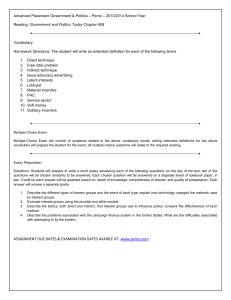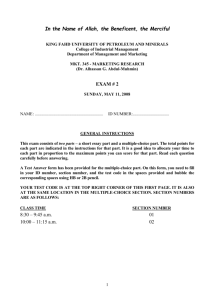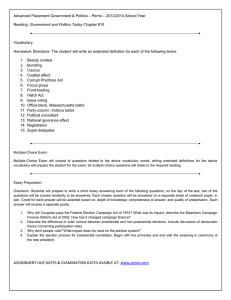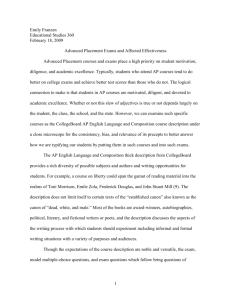A Study of Item Response and Anchor Bias in Economics... among Senior Secondary School Students in Osun State
advertisement
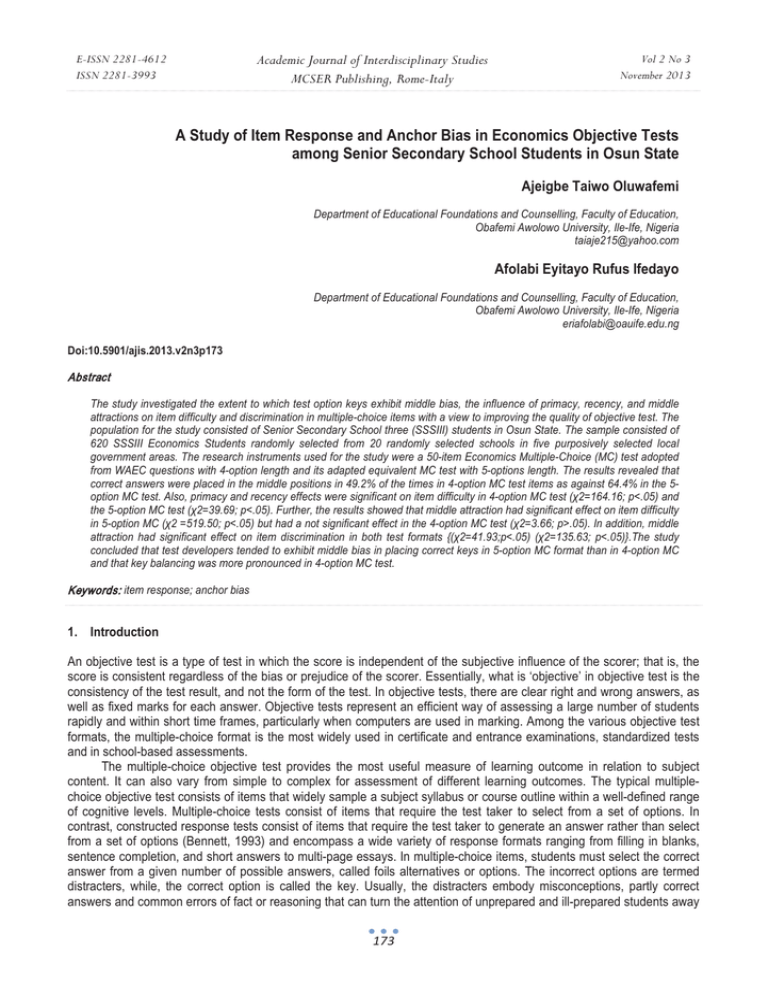
Academic Journal of Interdisciplinary Studies
MCSER Publishing, Rome-Italy
E-ISSN 2281-4612
ISSN 2281-3993
Vol 2 No 3
November 2013
A Study of Item Response and Anchor Bias in Economics Objective Tests
among Senior Secondary School Students in Osun State
Ajeigbe Taiwo Oluwafemi
Department of Educational Foundations and Counselling, Faculty of Education,
Obafemi Awolowo University, Ile-Ife, Nigeria
taiaje215@yahoo.com
Afolabi Eyitayo Rufus Ifedayo
Department of Educational Foundations and Counselling, Faculty of Education,
Obafemi Awolowo University, Ile-Ife, Nigeria
eriafolabi@oauife.edu.ng
Doi:10.5901/ajis.2013.v2n3p173
Abstract
The study investigated the extent to which test option keys exhibit middle bias, the influence of primacy, recency, and middle
attractions on item difficulty and discrimination in multiple-choice items with a view to improving the quality of objective test. The
population for the study consisted of Senior Secondary School three (SSSIII) students in Osun State. The sample consisted of
620 SSSIII Economics Students randomly selected from 20 randomly selected schools in five purposively selected local
government areas. The research instruments used for the study were a 50-item Economics Multiple-Choice (MC) test adopted
from WAEC questions with 4-option length and its adapted equivalent MC test with 5-options length. The results revealed that
correct answers were placed in the middle positions in 49.2% of the times in 4-option MC test items as against 64.4% in the 5option MC test. Also, primacy and recency effects were significant on item difficulty in 4-option MC test (Ȥ2=164.16; p<.05) and
the 5-option MC test (Ȥ2=39.69; p<.05). Further, the results showed that middle attraction had significant effect on item difficulty
in 5-option MC (Ȥ2 =519.50; p<.05) but had a not significant effect in the 4-option MC test (Ȥ2=3.66; p>.05). In addition, middle
attraction had significant effect on item discrimination in both test formats {(Ȥ2=41.93;p<.05) (Ȥ2=135.63; p<.05)}.The study
concluded that test developers tended to exhibit middle bias in placing correct keys in 5-option MC format than in 4-option MC
and that key balancing was more pronounced in 4-option MC test.
Keywords: item response; anchor bias
1. Introduction
An objective test is a type of test in which the score is independent of the subjective influence of the scorer; that is, the
score is consistent regardless of the bias or prejudice of the scorer. Essentially, what is ‘objective’ in objective test is the
consistency of the test result, and not the form of the test. In objective tests, there are clear right and wrong answers, as
well as fixed marks for each answer. Objective tests represent an efficient way of assessing a large number of students
rapidly and within short time frames, particularly when computers are used in marking. Among the various objective test
formats, the multiple-choice format is the most widely used in certificate and entrance examinations, standardized tests
and in school-based assessments.
The multiple-choice objective test provides the most useful measure of learning outcome in relation to subject
content. It can also vary from simple to complex for assessment of different learning outcomes. The typical multiplechoice objective test consists of items that widely sample a subject syllabus or course outline within a well-defined range
of cognitive levels. Multiple-choice tests consist of items that require the test taker to select from a set of options. In
contrast, constructed response tests consist of items that require the test taker to generate an answer rather than select
from a set of options (Bennett, 1993) and encompass a wide variety of response formats ranging from filling in blanks,
sentence completion, and short answers to multi-page essays. In multiple-choice items, students must select the correct
answer from a given number of possible answers, called foils alternatives or options. The incorrect options are termed
distracters, while, the correct option is called the key. Usually, the distracters embody misconceptions, partly correct
answers and common errors of fact or reasoning that can turn the attention of unprepared and ill-prepared students away
173
E-ISSN 2281-4612
ISSN 2281-3993
Academic Journal of Interdisciplinary Studies
MCSER Publishing, Rome-Italy
Vol 2 No 3
November 2013
from the correct answers.
In constructing or writing multiple-choice questions, the test writers usually look for where to hide or place option
keys. In an attempt to do this, they may consciously or unconsciously hide the key in a particular position repeatedly while
developing the alternatives of multiple-choice test. Sometimes it is a clear case of middle bias. That is placing the option
key in a central position as much as up to 3 to 4 times than other positions in the multiple-choice tests. Surprisingly,
writers are not aware of this tendency (Attali & Bar-Hillel, 2003). Banks of multiple-choice questions therefore usually
exhibit a bias of answers in middle positions. If the option keys are not reassigned to different positions, the resulting
option key could be heavily unbalanced. The popular method of dealing with this bias is through the so-called "delicate art
of key balancing". Key balancing is not an openly practiced policy.
Mentzer (1982) reported that the distributions of correct answers over positions in a four-option multiple-choice
tests revealed that answers are more often placed in a central position. On the other hand, the extent of the biasness
between the middle positions and edges positions according to & Attali & Bar-Hillel (2003) was found to be significantly
higher than expected by chance (52% in the four-choice tests and 64% in the five-choice tests). The variation recorded
around this proportion was relatively small.
The major concern among psychometricians is the order of writing the answers, which depends on how they occur
to the writer (i.e. anchoring/anchor bias) The stem and its correct key seem to be a natural point of departure for a
multiple – choice item. In this case, the writer may decide to write them down and there after construct distraction should
this word, there will be a preponderance of correct answers i.e. more than 1/k in the first position. If this trend thus
continues, the writer will find it difficult where the last distracter should be placed and this may eventually occupy the last
slot. Thereby leading to a preponderance of foil answers i.e. more than (k-1)/k in the last position. Anchoring might lead to
a different order, due to the tendency to bracket the correct number (the anchor) by destructors’ both large and smaller
(Inbar, 2002). Inbar 2002 also pointed it out that the tendency for test writers to exhibit anchor bias is the first position is
higher than any other position if the test writers decide to write the correct answer before other distracters.
The numerical answer options are often re-ordered monotonically (Haladyna & Downing, 1989) thus disguising the
original order in which they came to mind, the correct answer would be found in central positions more often then (k-2)/k.
Test takers on the other hand are trying to find out where the option key is located in a set of multiple-choice questions.
According to authors like Jerome (1986); Rogers (1991); and (Clark 1956), test takers do show some degree or level of
preference for particular option position at the expense of the others. Their findings reveal that the possible position to
find the option keys in a multiple-choice test is subject to the level of the difficulty level of the test items Authors like
Aghassi, (1994); and Fagley, (1997) had a contrary opinion that multiple-choice tests are relatively free from position
response bias.
Examining the inconsistency of these findings, Jessell and Sullins (1999) argued that selection of option key is not
only a function of the understanding of content material in the multiple-choice questions, but rather influenced essentially
by the first and last choice that are more outstanding than the middle position in both four and five-option length. The
possibility to select either the first or the last option will be higher especially when a test taker fails to go through the
alternatives the second time before making a selection.
It was recognised that not only may test takers show favouritism for certain positions, but they might also affect the
test writer in his placement of alternatives. Should the same positional factors manifest themselves in both the
examinee’s pattern of preferences and the test constructor’s arrangement of alternatives, the probability of correct
responses would be affected. To control this bias, an equal number of correct choices used as anchors (keys) should be
randomly scattered among the four and five positions of the multiple-choice tests.
However, regardless of the versatility and popularity of multiple-choice tests, performance on it is influenced by
response set, a consistent tendency of test takers to select a particular foil position, to work for speed rather than
accuracy, to gamble when in doubt (Afolabi, 1992; Ciardi, 2001; Gall and Spurthein, 1999). Types of response set have
been classified to include acquiescence, social desirability, response bias, guessing, and deviant response, among
others (Matfessel and Sax, 1958). Response sets are reported to be most apparent when items are ambiguous or when
they increase in level of difficulty (Gray, William and Henry 2002).
Response bias is a type of response set that reflects the tendency to select one response position in multiplechoice tests more frequently, not minding the item content of the test. It is also the tendency of test takers to respond in a
specific way regardless of test content. Response set is known to influence performance in objective tests and this may
be due to testwiseness.
Arising from the above, this study examined the extent to which test option keys exhibit middle bias, primacy and
recency effects, as well as effect of middle attraction on item difficulty and item discrimination of four-option and five174
E-ISSN 2281-4612
ISSN 2281-3993
Academic Journal of Interdisciplinary Studies
MCSER Publishing, Rome-Italy
Vol 2 No 3
November 2013
option multiple-choice Economics tests among Senior Secondary School Students in Osun State
2. Statement of the Problem
In objective tests particularly in four-option and five-option multiple-choice tests, it is hard to say preponderance in which
test developers favour middle positions or bias to middle positions as the place to hide the option keys (Bar-Hillel and
Attali, 2002). The middle bias in tests is a manifestation of the general phenomenon of edge aversion which in spite of
some attempts (Shaw, Berger, Brown, & Gallagher, 2000) is still in search of an explanation. The possible position
tendencies and item response still remain major areas needed to be investigated. It is not also clear whether students’
testwiseness is as a result gender differences, or variation in schools. It is also not known whether the items whose keys
are placed in the middle positions will have any influence or effect on the item discrimination of the Multiple-Choice test
items than those that are placed in the first or last position in both the four and five option length of multiple-choice tests.
3. Purpose of the Study
The study was conducted to:
i.
determine the extent to which test answer keys exhibit middle bias in four – option and five – option multiple –
choice test;
ii.
investigate primacy and recency effects in multiple-choice test on item difficulty and;
iii.
examine the effects of middle attraction on items difficulty and discrimination.
4. Research Question
i.
Do test option keys exhibit middle bias or edge bias in four-option and five-option of the Multiple-Choice test
items?
5. Research Hypotheses
i.
ii.
iii.
There is no significant influence of primacy and recency positions on the item difficulty of the multiple-choice
test items.
There is no significant effect of middle attraction on the item difficulty of the multiple-choice test items.
There is no significant effect of middle attraction on the discrimination level of the multiple-choice test items.
6. Methodology
The population for the study consisted of all the students who offered Economics at level three in the Senior Secondary
Schools in all the 30 Local Government Areas (LGAs) in Osun State. Five Local Government Areas were randomly
selected consisting of 104 schools with 11,240 SSSIII Economics students. From the 104 schools, 8 private and 12 public
schools were selected using stratified random sampling technique using school ownership as the strata. From each
school, intact class was used and thereafter, 31 answer sheets of students that sat for the test were randomly selected
before marking. Thus, the total sample size was 620. Two research instruments were used for the study. The first was
Economics Multiple-Choice (MC) test adopted from WAEC questions. In this MC test each item has 4-options. The
second was an adapted equivalent MC test with 5-options. The internal reliability coefficients of the adapted MC test
yielded 0.77.
7. Results
Research Question 1: Do test option keys exhibit middle bias or edge bias in four-option and five-option of the MultipleChoice test items?
175
E-ISSN 2281-4612
ISSN 2281-3993
Academic Journal of Interdisciplinary Studies
MCSER Publishing, Rome-Italy
Vol 2 No 3
November 2013
Table 1: Percentage distribution of option keys in WAEC and NECO 4-option length and 5-option length for five years
respectively
WAEC( 4-Option Length)
Bias
Middle
Edge
Years
B+C
A+D
F
%
F
%
2002
20
40.0
30
60.0
2003
26
52.0
24
48.0
2004
29
58.0
21
42.0
2005
26
52.0
24
48.0
2006
22
44.0
28
56.0
Total
123 49.2 127 50.8
NECO (5-Option Length)
Bias
Middle
Edge
B+C+D
A+E
F
%
F
%
37
61.7
23
38.4
38
63.3
22
36.7
34
56.7
26
43.4
35
58.3
25
41.6
37
61.6
23
38.4
181 60.4 119 39.7
Table 1 showed percentage distribution of correct answers keys in WAEC and NECO Economics items between 2002
and 2006. In 2002, a total of 40% of the correct keys were placed in the middle (B+C) as against 60% for the extreme
position (A+D). In 2003,52% in the middle as against 48% at the edge. In 2004, 58% in the middle, while the extreme
options were made the keys in 42% of time. In 2005, 52% in the middle and 48% in the extreme. In 2006, 44% in the
middle, while 56% in the first and the last positions. Arising from this, it could be observed that the positioning of the keys
in 2002 and 2006 was a clear case of edge bias, while in 2003, 2004, and 2005, test writers were middle bias in placing
the keys. The implication of this is that the WAEC four-option MC tests do exhibit middle bias more frequently than edge
bias. Similarly, in NECO 5-option length, it can be seen that in 2002, 61.7% in the middle (B+C+D) as against 38.4% for
the extreme ones (A+E). In 2003, 63.3% in the middle as against 36.7% in the edges. In 2004, 56.7% in the middle, while
the extreme options were made the keys in 43.4% of time. In 2005, 58.3% in the middle, 41.6% in the edges. Lastly in
2006, 61.6% in the middle, while 38.4% for first and the last positions. The percentage of time the first and last position
was used as keys tally with that of the 2002. Hence, positioning of the correct answers in 5-option NECO Economics MC
test items favoured the three middle positions than the extreme positions. It can therefore be concluded the NECO test
developers are also middle biased in the positioning of the keys.
Research Hypothesis 1: This hypothesis states that there is no significant influence of primacy and recency
positions on the item difficulty of the MC tests.
In testing this hypothesis item analysis was carried out on each of the items in the 2005 adopted and adapted
WAEC 50 Economics MC test, after which the difficulty index was grouped into three, Very difficult (0 P 0.25),
Moderately difficult (0.26 P 0.74) and very easy (0.75 P 1) according to Hopkins (1998) grouping.
Table 2: Chi-square analysis showing the effects of primacy and recency on item difficulty of 4-option multiple-choice
test.
Item Difficulty
Very Difficult
Moderately Difficult
0 P 0.25
(0.26 P 0.74)
O
E
O
E
A
535
546.76
3162
3249.54
D
469
457.24
2805
2717.45
Total
1004 1004.00
5967
5966.99
* Significant at 0.05, O - Observed Value, E – Expected Value
Primacy
&
Recency
Very Easy
(0.75 P 1)
O
E
236 136.69
15
114.31
251 251.00
Total
O
3933
3289
7222
Ȥ2
p
164.16*
<.05
From Table 2, the items whose difficulty level falls within 0 P 0.25 (very difficult) had options A and D which are the
primacy and recency picked 535 and 469 times respectively as the key by the candidates. Also items with moderate
difficulty (0.26 P 0.74) levels had option A picked as the key 3162 times, while option D was picked 2805 times as the
key. For item with low difficulty (0.75 P 1), options A and D were picked 236, and 15 times as the key respectively.
The chi-square analysis yielded (Ȥ2 = 164.16) which is significant at the 0.05 level. This implies that primacy and recency
positions have significant influence on item difficulty of 4-multiple-choice test. Hence, primacy has more patronage than
recency positions in four option MC test.
176
Academic Journal of Interdisciplinary Studies
MCSER Publishing, Rome-Italy
E-ISSN 2281-4612
ISSN 2281-3993
Vol 2 No 3
November 2013
Table 3: Chi-square analysis showing the effects of primacy and recency options on item difficulty of 5-option multiplechoice test.
Primacy
&
Recency
A
E
Total
Very Difficult
0 P 0.25
O
E
500 570.81
300 229.19
800 800.00
Item Difficulty
Moderately Difficult
(0.26 P 0.74)
O
E
2789
2714.22
1015
1089.78
3804
3804.00
Very Easy
(0.75 P 1)
O
E
26
29.97
16
12.03
42
42.00
Total
O
3315
1331
4646
Ȥ2
p
39.69*
<.05
From Table 3, primacy options (A), and recency option (E) were picked 500, and 300 times respectively as key very
difficult items, while for moderately difficult items, primacy and recency options were picked 2789 and 1015 times
respectively. Furthermore in the very easy difficulty level items options A and E were picked as the keys 26 and 16 times
respectively. A chi-square analysis of the data yielded Ȥ2 =39.69 which is significant at p < .05. That is, there is a
significant influence of primacy and recency positions on item difficulty in five-option multiple-choice tests. Hence,
students patronize primacy than recency in 5-options of the MC test.
Research Hypothesis 2: The second hypothesis states that there is no significant influence of middle attraction on
the item difficulty of the multiple-choice test items. Having grouped the items into very difficult, moderately difficult and
very easy levels of difficulty, the number of times the students picked the middle options (i.e. B and C) as the key was
sorted out. Chi-square analysis was then used to determine the influence of middle attraction on the difficulty level of the
items.
Table 4: Chi-square analysis showing the effects of middle attraction on the item difficulty of 4-option multiple-choice test.
Middle
Attraction
B
C
Total
Very Difficult
0 P 0.25
O
E
597
567.14
537
566.86
1134 1134.00
Item Difficulty
Moderately Difficult
(0.26 P 0.74)
O
E
3414
3443.85
3472
3442.14
6886
6886.00
Very Easy
(0.75 P 1)
O
E
28
28.00
28
27.99
56
55.99
Total
O
4039
4037
8076
Ȥ2
p
3.66
>.05
From Table 4, the chi-square result yielded a value of Ȥ2 =3.66 which is not significant at p>.05. That is, for 4-option
multiple-choice test, the candidates’ preference for options in the middle position has no significant influence on the
difficulty of the test items. Hence, students patronize middle positions equally in 4-option MC test.
Table 5: Chi-square analysis showing the effects of middle attraction on the item difficulty of 5-option multiple-choice test.
Middle
Attraction
B
C
D
Total
Very Difficult
0 P 0.25
O
E
604
572.65
515
585.91
504
464.43
1623 1622.99
Item Difficulty
Moderately Difficult
(0.26 P 0.74)
O
E
3137
3089.78
3316
3161.34
2304
2505.88
8757
8757.00
Very Easy
(0.75 P 1)
O
E
16
94.56
13
96.75
239
76.69
268 268.00
Total
O
3757
3844
3047
10648
Ȥ2
p
519.50*
<.05
From Table 5, the chi-square result yielded a values of Ȥ2 =519.50 which is significant at p>.05. That is, for five-option
multiple-choice test, the candidates’ preference for options in the middle position has significant influence on the item
difficulty of the test. Hence, students prefer to choose the middle point (C) than other middle positions.
Research Hypothesis 3: The third hypothesis states that there is no significant effect of middle attraction on the
discrimination level of the MC tests. In testing this hypothesis the discrimination index of the items were determined and
grouped into excellent (0.40 D 1), good (0.30 D 0.39), fair (0.11 D 0.29) and poor (0.01 D 0.10)
discrimination levels in accordance to Hopkins (1998) grouping.
177
Academic Journal of Interdisciplinary Studies
MCSER Publishing, Rome-Italy
E-ISSN 2281-4612
ISSN 2281-3993
Vol 2 No 3
November 2013
Table 6: Chi-square analysis showing the effects of middle attraction, on item discrimination of 4-option multiple-choice
test.
Middle
Attraction
B
C
Total
Excellent
Discrimination
(0.40D 1)
O
1866
1815
3681
E
1841.96
1840.04
3681.00
Item Discrimination
Good
Fair
Discrimination
Discrimination
(0.30 D
(0.11 D
0.39)
0.29)
O
E
O
E
890
988.24
558
567.64
1086
987.76
577
567.36
1976 1976.00 1135 1135.00
Poor
Discrimination
(0.01 D
0.10)
O
E
725
642.16
559
641.84
1284 1284.00
Total
O
4039
4037
8076
Ȥ2
p
41.93*
<.05
From Table 6, It could be observed that for the excellently discriminating items the two middle option were chosen as the
key in a total of 3681 times, while the good discriminating items attracted options B and C as the correct answer in a total
of 1976 times. The fair and poorly discriminating items attracted options B and C as the keys in 1125 and 1284 times
respectively. The result of the analysis yielded a significant chi-square value (Ȥ2 = 41.93, p < .05). This implies that there
is significant effect of middle attraction on item discrimination levels of 4-option item length.
Table 7: Chi-square analysis showing the effect of middle attraction on item discrimination of 5- option item length.
Middle
Attraction
B
C
D
Total
Excellent
Discrimination
(0.40D 1)
O
1911
2065
1417
5393
E
1902.85
1946.91
1543.24
5393.00
Item Discrimination
Good
Fair
Discrimination
Discrimination
(0.30 D
(0.11 D
0.39)
0.29)
O
E
O
E
594
703.20
935
875.74
639
719.49
843
896.02
760
570.31
7O4
710.24
1993 1993.00 2482 2482.00
Poor
Discrimination
(0.01 D
0.10)
O
E
317 275.21
297 281.59
166 223.20
780 780.00
Total
O
3757
3844
3047
10648
Ȥ2
p
135.63*
<.05
From Table 7, it could be observed that options B, C and D were chosen as the key in 1911, 2065 and 1417 times
respectively for items with excellent discrimination. Also for the fairly discriminating items and the poorly discriminating
items option B was chosen to be the key in 935 and 317 times respectively while option C was chosen in number of 843
and 297 times and option D in 704 and 166 times. Also, the middle options were chosen as the keys in a total of 1993
times for good discriminating items. A chi-square analysis of the result yielded Ȥ2 = 135.63, which is significant at p < .05.
Thus, middle attraction has significant relationship with item discrimination levels in 5-option item length.
8. Discussion
From the results of the data analysis, it was found that the nature of item-key positioning for both WAEC and NECO
followed the same trend, but middle bias was more pronounced in 5-option MC format than 4-option MC format. This
result is in agreement with research findings, that test developers prefer placing the key in the middle position in 5-option
MC format than four-option MC format (Attali & Bar-Hillel, 2001; Haladyna & Downing, 1989 and Inbar, 2002. This study
also revealed that positional response bias (e.g. middle bias and edge bias middle) has significant influence on item
difficulty of the 4-option and 5-option multiple-choice test. This supported the finding by Attali & Bar-Hillel (2003) that
people seek answer to multiple-choice question in the middle position. Another finding of this study shows that there is
significant relationship between middle attraction and the discrimination level of Multiple-choice tests in the two test
formats. This agreed with the finding of Attali & Bar-Hillel (2003) who found that positional response affects the various
discrimination values.
178
E-ISSN 2281-4612
ISSN 2281-3993
Academic Journal of Interdisciplinary Studies
MCSER Publishing, Rome-Italy
Vol 2 No 3
November 2013
9. Conclusion and Recommendations
The study concluded that test developers tended to exhibit middle bias in placing correct keys in 5-option MC format than
in 4-option MC and that key balancing was more pronounced in 4-option MC test.
Based on the findings of this study, the following recommendations were made:
1. Both WAEC and NECO should invite stakeholders in examination bodies to seminars where constant review
of items can be discussed.
2. Examination bodies like WAEC and NECO should to encourage Universities experts in multiple-choice test
items development to participant in generating quality tests items that will be free of any form of biasness be it
in the stems, key placement and distractors.
3. NECO should try as much as possible to practise key randomization via the use of computer for easy and
quick placement.
4. Both WAEC and NECO should encourage and give privilege to teachers in the secondary schools to
participate in seminars that can improve the quality development of teacher’s made tests as well as the
intricacy of constructing good, quality MC tests.
References
Afolabi, E.R.I. (1992). Effects of test format, self-concept, and anxiety of response changing behaviour. Journal of Education and
Society, 2 (1), 39-46.
Aghassi, M.E. (1990). Getting good grades: how to succeed in college. Englewoo Cliffs: Prentices-Hall Inc.
Attali, Y., & Bar-Hillel, M. (2003). Guess where: The position of correct answers in multiple-choice test items as a psychometric variable.
Journal of Educational Measurement, 40, 109-128.
Bar-Hillel, M., & Attali, Y. (2002). Seek whence: answer sequences and their consequences in key-balanced multiple-choice tests. The
American Statistician, 56, 299-303.,
Bennett, R. E. (1993). On the meanings of constructed response. In R. E. Bennet & W. C. Ward (Eds.), Construction versus choice in
cognitive measurement: Issues in constructed response, performance testing, and portfolio assessment (pp. 1-27). Hillsdale, NJ:
Lawrence Erlbaum.
Ciardi, F. (2001). Test difficulty, validity, and reliability as functions of selected multiple-choice item construction principles. Educational
Psychological Measurement, 19, 171-179.
Clark, E. C. (1956). General response patterns to five-choice items. Journal of Educational Psychology, 47, 110-117.
Fagley, N.S. (1997). Positional response bias in multiple-choice tests of learning: its relation to testwiseness and guessing strategy.
Journal of Educational Measurement, 17, 241-46.
Gall, C. & Spurtheim, L. (1999). The effect of keyed response sequencing of multiple-choice items on performance and reliability. Journal
of Educational Measurement, 21: 45-48.
Gray, E. William, I. & Henry, F. (2002). Uncertain responsed on multiple- choice examinations. Psychological Reports, 18, 801-6.
Haladyna, T.M. & Downing, S.M. (1989). Validity of a taxonomy of multiple-choice item-writing rules. Applied Measurement in Education,
2 (1), 51-78.
Inbar, N. (2002). Middle bias in numerical answers to multiple-choice questions. Unpublished Master’s Thesis, the Hebrew University,
Jerusalem, Israel.
Jessell, T. & Sullins, B. (1999). The reliability of a multiple-choice examination under various test-taking instructions. Journal of
Educational Measurement, 5, 307-14.
Metfessel, N.S. & Sax, G. (1997). Systematic biases in the keying of correct responses on certain standardized tests. Educational and
Psychological Measurement, 18, 787-790.
Mentzer, T. L. (1982). Response biases in multiple-choice test item files. Educational and Psychological Measurement, 42, 437-448.
Rogers, H. J. (1999). Guessing in multiple choice tests. In: Masters, G. N. & Keeves, J. P. (Eds.), Advances in Measurement in
Educational Research and Assessment (pp. 235-243). Amsterdam: Pergamon.
Shaw, J.I., Bergen, J.E., Brown, C.A. & Gallagher, M.E. (2000). Centrality preference in choices among similar options. The Journal of
General Psychology, 127: 157-164.
179
